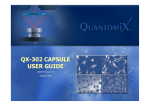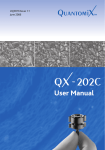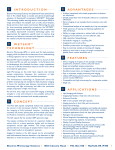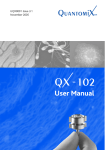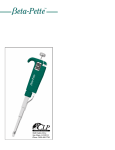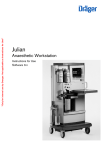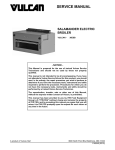Download QX-202C Graphic Guide
Transcript
QX-202C CAPSULE QUICK USER GUIDE UQX017 Issue 1.1 June 2006 General precautions Use powder-free gloves only During preparation and storage, never place capsules on any surface other than the Capsule Plate Never touch the capsule membrane Refer to QX-202C user manual and Quick Imaging Guide for further information Step 1: Check Starter Kit contents QX-202C Capsules: Each plastic strip containing 12 capsules One box of Gilson Microman® pipette One box of 100 capillaries Two boxes of 50 pistons each x2 MP-12 Capsule Plates: 2 boxes containing one plate and cover each One box containing: IB-64 Imaging Buffer RT-56 Calibration Capsule QX-202C User Manual and Quick Imaging guide Step 2: Open Imaging Buffer and Calibration Capsule box Use caution when using sharp objects IB-64 Imaging Buffer Note: Read data sheets RT-56 Calibration Capsule Step 3: Reconstitute Imaging Buffer Open metal cap a Open rubber seal b d Shake vial to fully dissolve powder Add 1ml of double distilled water c Step 4: Open MP-12 Capsule Plate box Use caution when using sharp objects a c b d Step 5: Place the Calibration Capsule on plate Fit capsule wings in slots a b Turn sealing stub counterclockwise to open c Sealing Stub Sample Dish Step 6: Add Imaging Buffer to Calibration Capsule b a Add 15μl Imaging Buffer by Close capsule – turn stub clockwise using the Microman®. See instructions in step 11 c Do not touch the capsule membrane with the piston Optimize your SEM imaging parameters by the using the calibration capsule. For calibration capsule imaging instructions see the Quick Guide for Imaging with WETSEM™ Capsule is properly sealed only when wings are aligned Step 7: Check expiry & record lot Note: Expiry is 18 months after production date Year Month Record QX-202C lot number Step 8: Open the QX-202C box Use caution when using sharp objects a b c d Step 9: Place capsules on plate a d b c Fit capsule wings in slots e Turn counter-clockwise to open Step 10: Remove the Sealing Stub Sealing Stub If the rubber seal accidentally detaches from the stub, reposition it with the flat surface away from the liquid dish Sample Dish Note: Once removed, store the sealing stub in its original package for future use Step 11: Using the Applicator; Description Push button Thumbwheel for setting the volume Using the push button Stem Top Volumeter First stop Second stop Piston Capillary-piston holder Clamp inside Capillary Detailed Microman instructions for use can be found in the Gilson Microman® user guide Step 12: Using the Applicator; Mounting the capillary-piston a Press the push-button to the second stop to open the clamp and slide the stem into the clamp b Slide the mounted piston into the capillary and push until it snaps onto the capillaryholder Detailed Microman instructions for use can be found in the Gilson Microman® user guide Step 13: Using the Applicator; Pipetting b a Top First stop Second stop Set the volume by turning the volumeter For aspirating and dispensing press the pushbutton to the first stop Detailed Microman instructions for use can be found in the Gilson Microman® user guide Step 14: Sample preparation Prepare the reaction mixture a Aspirate 6.5 - 7.5µl of the mixture Wipe liquids outside the capillary b Make sure the capillary is correctly filled 9 X Step 15: Preparing the sample Close capsule – turn stub clockwise a Dispense the sample into the sample dish Do not touch the capsule membrane with the piston c b Gently tap the plate against the bench top Capsule is properly sealed only when wings are aligned Final step: Place capsule in SEM Gently tilt and pull to remove Note: Label here using a felt tip marker for future identification • Set stage at minimal height • Capsule membrane should face up • Capsule’s height is 18mm (Above stage surface – 10mm) • A stub adaptor may be required Sample is now ready for WETSEM imaging Recommended SEM parameters Suitable Parameter Range for WETSEM™ Imaging Parameter Recommended Range Comments Acceleration Voltage 15 - 30 kV Not lower than 10.0 kV Probe Current (based on source type) Tungsten filament 0.4 – 1.0 nA Not higher than 1.0 nA FEG 0.1 - 0.5 nA Not higher than 0.5 nA Working Distance (based on detector type) Semiconductor (BSE) 6 - 10 mm Acceptable 5 -15 mm Robinson (BSE) 10 - 20 mm Better efficiency at high kV Scintillator (BSE) 6 -10 mm Acceptable 6 -10 mm Everhart-Thornley (SE) 8 -12 mm Acceptable 6 -15 mm In-lens / Through the lens 2 – 4 mm Manufacturer dependent For further assistance and inquiries please contact our support department at [email protected]




















